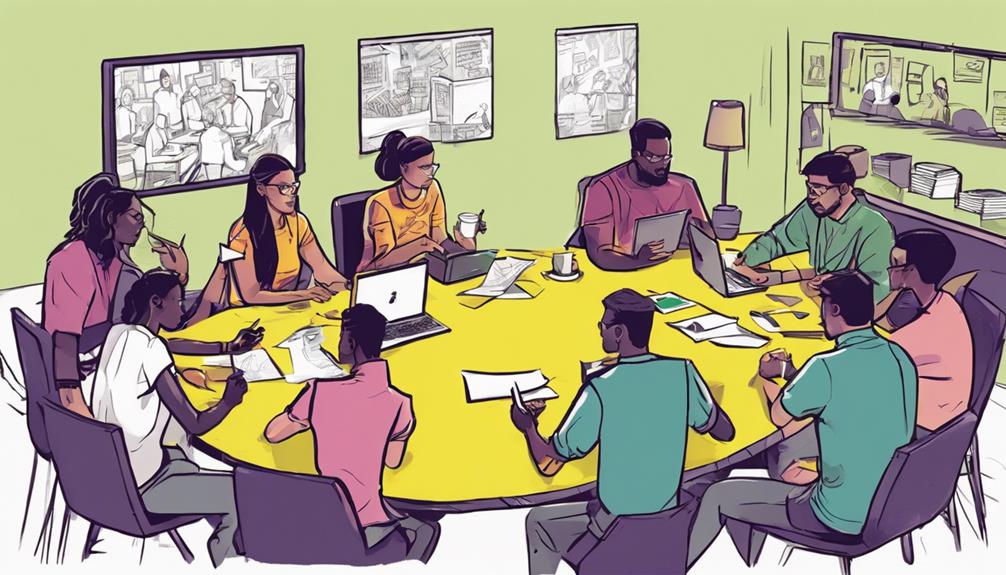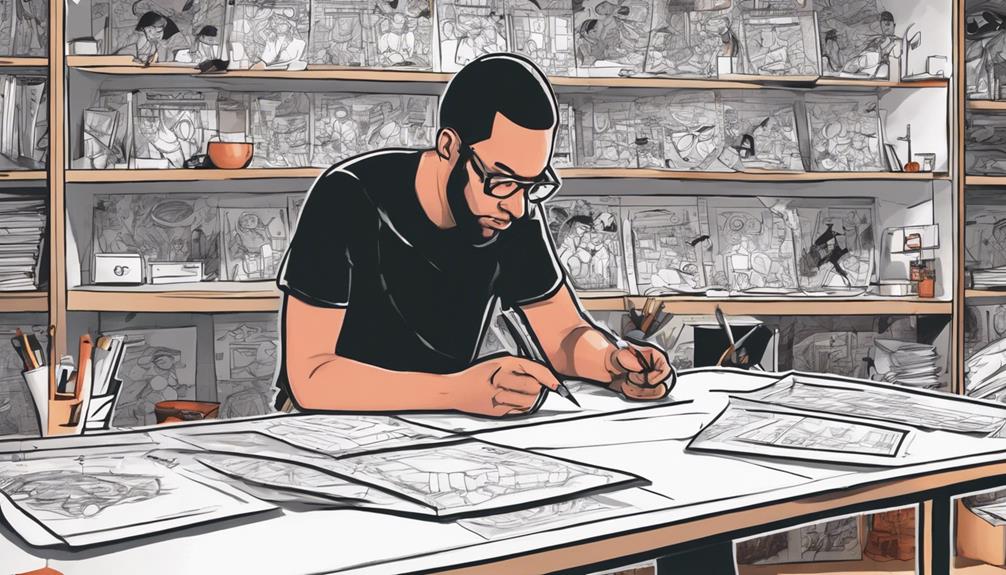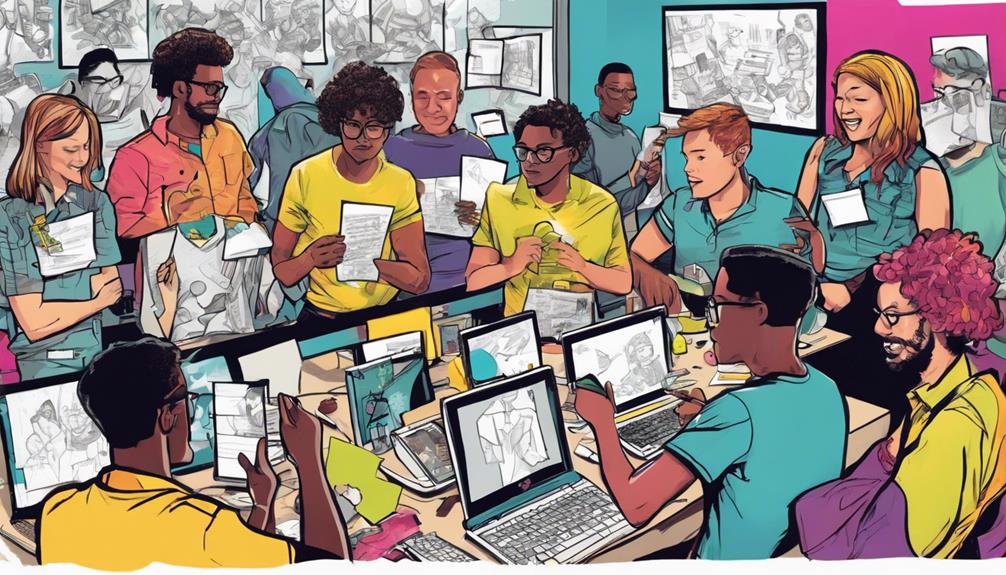Begin your design thinking journey with 7 critical steps. Start by empathizing with users to grasp their needs. Define the problem clearly to drive your design process. Allow your ideas to flow freely to explore a plethora of solutions. Prototype to visualize and test your concepts in real-world scenarios. Test your solutions with users for crucial feedback. Embrace iterative refinement to fine-tune your designs based on insights. These steps will transform how you approach problems and foster innovation.
Key Takeaways
- Empathize with users to understand their needs deeply.
- Define the problem space clearly for focused design.
- Ideate to explore diverse solutions creatively.
- Prototype to visualize and test ideas efficiently.
- Test solutions with users for valuable feedback and refinement.
Problem Identification
To start the design thinking process effectively, you must first identify the problem at hand with clarity and precision. This vital step involves management of defining the problem space before exploring potential solutions.
Through brainstorming sessions and critical thinking skills, designers explore the problem space to understand its intricacies. By examining the problem space thoroughly, you can uncover key insights that will guide the design process towards effective solutions.
Prototyping and user feedback on potential ideas are then applied to refine and iterate on these solutions. It's essential to leverage creativity to effectively solve the identified problem, ensuring that the solutions align with user requirements.
User Involvement

You play a vital role in the design process by actively participating in understanding your needs and preferences.
By immersing yourself in the environment and sharing your insights, you help shape solutions that cater to your challenges and expectations.
Your feedback on prototypes refines designs to guarantee they meet your requirements effectively.
Active User Participation
During the design thinking process, active user participation plays a significant role in guaranteeing that solutions are user-centric and effective. Engaging users in the design process allows for the collection of valuable feedback and insights that lead to innovative solutions.
By involving users in prototyping and testing phases, you can tailor products or services to meet their needs and preferences, resulting in higher satisfaction and ownership. User participation not only helps in identifying key pain points early on but also fosters a sense of collaboration and co-creation.
This collaborative approach ensures that the final outcome resonates with users, increasing the likelihood of successful adoption. By prioritizing user-centric solutions through active user participation, you can create products or services that truly address user needs and provide meaningful value.
User-Centric Approach
Active user participation leads to a user-centric approach in the design thinking process, ensuring that solutions are tailored to meet user needs and preferences effectively. By engaging users through interviews, observations, and feedback, designers gain valuable insights into their perspectives and challenges, ultimately leading to more user-friendly designs that resonate with the target audience.
Involving users early and consistently throughout the design process increases the likelihood of creating successful and impactful solutions that address real user concerns.
A user-centric approach in design thinking emphasizes designing with the end user in mind to enhance the overall user experience and satisfaction with the final product or service. By actively involving users in the design process, designers can better understand user preferences and create solutions that truly meet their needs.
This approach not only leads to more effective designs but also helps in building products that users find intuitive, engaging, and valuable.
Idea Generation

In the design thinking process, idea generation plays an essential role in exploring a wide range of creative solutions through techniques like brainstorming and mind mapping. Brainstorming allows for the generation of diverse ideas, while mind mapping helps in organizing and connecting these thoughts visually.
Techniques such as SCAMPER, which stands for Substitute, Combine, Adapt, Modify, Put to another use, Eliminate, and Reverse, can further enhance the creative process by prompting innovative thinking.
Encouraging diverse participants in the idea generation stage can lead to a broader range of perspectives and ideas, fostering more innovative solutions. Rapid prototyping and sketching are valuable tools to quickly visualize and refine these generated ideas, allowing for a tangible representation of concepts.
During idea generation, the primary goal is to explore possibilities and push the boundaries of conventional thinking to uncover unique and effective solutions. This step is fundamental in the design thinking process as it sets the foundation for the subsequent stages of prototyping and testing.
Prototyping and Testing

Now, let's discuss Prototype Validation Techniques and Iterative Testing Approaches. These methods are essential for refining your designs through feedback and user insights.
Prototype Validation Techniques
Prototype validation methods are vital in the design thinking process to guarantee the feasibility and functionality of the solution. Testing prototypes with end-users is essential for gathering feedback and insights to refine the design.
Usability testing, A/B testing, and focus groups are commonly used methods for prototype validation. Through iterative prototyping and testing cycles, continuous improvement and validation of design decisions can be achieved.
By validating prototypes early in the design process, the risk of costly errors is reduced, securing user satisfaction. These techniques not only help in evaluating the usability and functionality of the solution but also aid in making informed design decisions based on real user feedback.
Engaging with end-users throughout the prototype validation process ensures that the final product meets their needs and expectations, ultimately leading to a more successful and user-centric design.
Iterative Testing Approaches
Utilizing iterative testing approaches is vital in refining designs and ensuring the final product aligns with user needs and expectations. Prototyping plays a pivotal role in this process by creating scaled-down versions of the product for testing and feedback. By testing these prototypes, valuable insights are gathered, flaws are identified, and necessary improvements are made. Iterative testing allows for the continuous refinement of designs, enhancing usability, and ensuring that the end product meets user needs effectively.
| Key Points | Description |
|---|---|
| Prototyping | Creating scaled-down versions of the final product for testing and feedback |
| Testing | Gathering insights, identifying flaws, and making necessary improvements |
| Iterative Testing | Refining designs, enhancing usability, and ensuring the final product meets user needs |
| Feedback | Essential for design iterations, validating ideas and solutions, and receiving continuous feedback |
In the design thinking process, prototyping and testing are fundamental steps to validate ideas and solutions. Continuous feedback obtained through testing informs design iterations, leading to more effective and user-centered solutions.
Iterative Refinement

Continuously honing your designs through feedback loops is key to iterative refinement in the design thinking process. This approach involves ongoing improvement by adjusting solutions based on insights gained from testing and iteration.
It focuses on perfecting prototypes through multiple cycles of testing to make gradual enhancements that better align with user-centered outcomes. By embracing iterative refinement, you can create successful solutions that effectively address complex problems.
This process ensures that the final product isn't only aligned with the desired outcomes but also meets user needs and expectations. Through iterative refinement, design thinkers can optimize their ideas and solutions to deliver more robust and user-friendly outcomes.
Implementation Evaluation

Evaluate the effectiveness and impact of your design thinking solutions through implementation evaluation. Measure key performance indicators (KPIs) to gauge the success of your project.
Analyze data on user satisfaction, efficiency, and other relevant metrics to determine if goals were met. Seek stakeholder feedback to identify areas for improvement.
Use this feedback to refine and optimize your design thinking processes.
Continuous Improvement

To enhance your design thinking process, regularly refine solutions based on feedback to achieve the best outcomes. Continuous improvement involves iterative refinement, adapting to changing needs, and ensuring best outcomes. By reflecting on past successes and challenges, you can inform future design decisions and stay relevant in the ever-evolving landscape of design thinking. Embracing continuous improvement is essential for staying innovative and responsive to the evolving requirements of your projects.
| Key Points | Description |
|---|---|
| Reflecting on past successes | Analyze what worked well in previous designs to replicate success. |
| Refining solutions | Continuously improve and adjust your solutions based on feedback. |
| Adapting to changing needs | Stay flexible and update your designs to meet new requirements. |
Continuous improvement in design thinking is about striving for excellence through ongoing enhancements. It enables you to not only meet current needs but also anticipate future challenges, making your design solutions more effective and impactful.
Frequently Asked Questions
What Are the 7 Steps of Critical Thinking?
Identify the problem, gather information, analyze it, develop solutions, select the best one, implement it, and evaluate the outcome. Critical thinking involves questioning assumptions, recognizing biases, evaluating evidence, considering perspectives, and drawing conclusions.
What Are the Five 5 Steps of Design Thinking?
So, you wanna know the five steps of design thinking? Easy peasy! First, understand user needs. Second, define the prob. Third, get those creative juices flowing. Fourth, make a prototype. Fifth, test it out!
What Is the Most Critical Step in the Design Process?
Understanding the problem thoroughly is key in the design process. You must conduct research, gather insights, and define the problem statement clearly. Without this step, solutions may miss the mark and fail to meet user needs.
What Is the Biggest Obstacle to Design Thinking?
Lack of empathy and understanding poses the biggest obstacle to design thinking. Guarantee you grasp users' needs. Allocate sufficient time and resources. Embrace change and collaboration. Iterate and test solutions with real users for best outcomes.
Conclusion
You absolutely can't miss these 7 vital design thinking steps! They're the key to accessing groundbreaking innovation and ensuring success in your projects.
From problem identification to continuous improvement, each step is pivotal in creating user-centered solutions that truly make an impact.
So, don't overlook these essential steps – they're the secret sauce to taking your design thinking to the next level!









